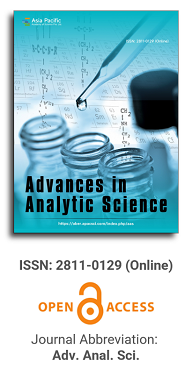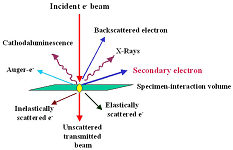
Asia Pacific Academy of Science Pte. Ltd. (APACSCI) specializes in international journal publishing. APACSCI adopts the open access publishing model and provides an important communication bridge for academic groups whose interest fields include engineering, technology, medicine, computer, mathematics, agriculture and forestry, and environment.

Bisphenol-A: quantification in the urine of pregnant women by gas chromatography-mass spectrometry
Vol 4, Issue 2, 2023
Download PDF
Abstract
The use of bisphenol-A (BPA) in global industry has been increasing in recent years, with emerging markets driving this growing demand. BPA applications in the food and beverage industry account for only 3% to 4% of global polycarbonate consumption, but its use is being re-examined as several scientific papers have come to light indicating a direct link between BPA and adverse health effects. Contamination of food and beverages occurs by migration of BPA from the containers that contain it (canned foods, wines, etc.), and is the main source of human exposure. To evaluate such exposure, an analytical method by gas chromatography coupled to mass spectrometry was developed and validated for the quantification of total BPA in urine of pregnant women attended at the Italian Hospital of Buenos Aires in 2013, with a limit of quantification of 2.0 ng/mL and a limit of detection of 0.8 ng/mL. Of the 149 urine samples analyzed, 66.4% were quantifiable, with the median total BPA of 4.8 ng/mL (4.3 ng/mg creatinine) and the geometric mean of 4.8 ng/mL (4.7 ng/mg creatinine).
Keywords
References
- VomSaal FS, Hughes C. An extensive new literature concerning low-dose effects of bisphenol A shows the need for a new risk assessment. Environmental Health Perspectives. 2005; 113(8): 926-933. doi: 10.1289/ehp.7713
- Gundert-Remy U, Bodin J, Bosetti C, et al. Bisphenol A (BPA) hazard assessment protocol. EFSA supporting publication; 2017. pp. 1-76.
- NTP Research report on the CLARITY-BPA core study: A perinatal and chronic extended-dose-range study of Bisphenol A in rats. NTP RR 9. Research Triangle Park, NC. NTP; 2018. pp. 1-221.
- Gerona RR, Pan J, Zota AR, et al. Direct measurement of Bisphenol A (BPA), BPA glucuronide and BPA sulfate in a diverse and low-income population of pregnant women reveals high exposure, with potential implications for previous exposure estimates: a cross-sectional study. Environmental Health. 2016; 15(1). doi: 10.1186/s12940-016-0131-2
- Boucher JG, Boudreau A, Ahmed S, Atlas E. In vitro effects of Bisphenol A -D-glucuronide (BPA-G) on adipogenesis in human and murine preadipocytes. Environ Health Perspect. 2015; 123(12): 1287-1293.
- Koch HM, Kolossa-Gehring M, Schröter-Kermani C, et al. Bisphenol A in 24 h urine and plasma samples of the German Environmental Specimen Bank from 1995 to 2009: A retrospective exposure evaluation. Journal of Exposure Science & Environmental Epidemiology. 2012; 22(6): 610-616. doi: 10.1038/jes.2012.39
- Arakawa C, Fujimaki K, Yoshinaga J, et al. Daily urinary excretion of bisphenol a. Environmental Health and Preventive Medicine. 2004; 9(1): 22-26. doi: 10.1265/ehpm.9.22
- Tsukioka T, Terasawa J, Sato S, et al. Development of Analytical Method for Determining Trace Amounts of BPA in Urine Samples and Estimation of Exposure to BPA. Journal of Environmental Chemistry. 2004; 14(1): 57-63. doi: 10.5985/jec.14.57
- Moors S, Blaszkewicz M, Bolt HM, et al. Simultaneous determination of daidzein, equol, genistein and bisphenol A in human urine by a fast and simple method using SPE and GC-MS. Molecular Nutrition & Food Research. 2007; 51(7): 787-798. doi: 10.1002/mnfr.200600289
- Kuklenyik Z, Ekong J, Cutchins CD, et al. Simultaneous Measurement of Urinary Bisphenol A and Alkylphenols by Automated Solid-Phase Extractive Derivatization Gas Chromatography/Mass Spectrometry. Analytical Chemistry. 2003; 75(24): 6820-6825. doi: 10.1021/ac0303158
- European Medicines Agency (EMA). Guideline on bioanalytical method validation. Available online: http://www.ema.europa.eu/docs/en_GB/document_library/Scientific_guideline/2011/08/WC500109686.pdf (accessed on 2 September 2022).
- Casas M, Valvi D, Luque N, et al. Dietary and sociodemographic determinants of bisphenol A urine concentrations in pregnant women and children. Environment International. 2013; 56: 10-18. doi: 10.1016/j.envint.2013.02.014
- Teeguarden JG, Calafat AM, Ye X, et al. Twenty-Four Hour Human Urine and Serum Profiles of Bisphenol A during High-Dietary Exposure. Toxicological Sciences. 2011; 123(1): 48-57. doi: 10.1093/toxsci/kfr160
- Braun JM, Kalkbrenner AE, Calafat AM, et al. Variability and Predictors of Urinary Bisphenol A Concentrations during Pregnancy. Environmental Health Perspectives. 2011; 119(1): 131-137. doi: 10.1289/ehp.1002366
- Giesbrecht GF, Ejaredar M, et al. Prenatal bisphenol an exposure and dysregulation of infant hypothalamic- pituitary-adrenal axis function: findings from the APrON cohort study. Environmental Health. 2017; 16(1). doi: 10.1186/s12940-017-0259-8
- Chiu YH, Mínguez-Alarcón L, Ford JB, et al. Trimester-Specific Urinary Bisphenol A Concentrations and Blood Glucose Levels Among Pregnant Women from a Fertility Clinic. The Journal of Clinical Endocrinology & Metabolism. 2017; 102(4): 1350-1357. doi: 10.1210/jc.2017-00022
- Johns LE, Ferguson KK, Cantonwine DE, et al. Urinary BPA and Phthalate Metabolite Concentrations and Plasma Vitamin D Levels in Pregnant Women: A Repeated Measures Analysis. Environmental Health Perspectives. 2017; 125(8). doi: 10.1289/ehp1178
- Huo W, Xia W, Wan Y, et al. Maternal urinary bisphenol A levels and infant low birth weight: A nested case– control study of the Health Baby Cohort in China. Environment International. 2015; 85: 96-103. doi: 10.1016/j.envint.2015.09.005
- Myridakis A, Fthenou E, Balaska E, et al. Phthalate esters, parabens and bisphenol-A exposure among mothers and their children in Greece (Rhea cohort). Environment International. 2015; 83: 1-10. doi: 10.1016/j.envint.2015.05.014
- Arbuckle TE, Davis K, Marro L, et al. Phthalate and bisphenol A exposure among pregnant women in Canada— Results from the MIREC study. Environment International. 2014; 68: 55-65. doi: 10.1016/j.envint.2014.02.010
- Lee BE, Park H, Hong YC, et al. Prenatal bisphenol A and birth outcomes: MOCEH (Mothers and Children’s Environmental Health) study. International Journal of Hygiene and Environmental Health. 2014; 217(2-3): 328- 334. doi: 10.1016/j.ijheh.2013.07.005
- Hoepner LA, Whyatt RM, Just AC, et al. Urinary concentrations of bisphenol A in an urban minority birth cohort in New York City, prenatal through age 7 years. Environmental Research. 2013; 122: 38-44. doi: 10.1016/j.envres.2012.12.003
Supporting Agencies
Copyright (c) 2023 Gabriel Guillermo Cases, Raul Eduardo Uicich, Paula Kandel Gambarte, Marcela Liliam Vázquez, Claudio Fernando Moix, Analía Ferloni, Flavia Alejandra Vidal, Lucas Otaño, Silvana Figar, Soledad Aragone, María Isabel Giménez

This work is licensed under a Creative Commons Attribution 4.0 International License.

This site is licensed under a Creative Commons Attribution 4.0 International License (CC BY 4.0).
1.jpg)
Prof. Sivanesan Subramanian
Anna University, India





.jpg)
